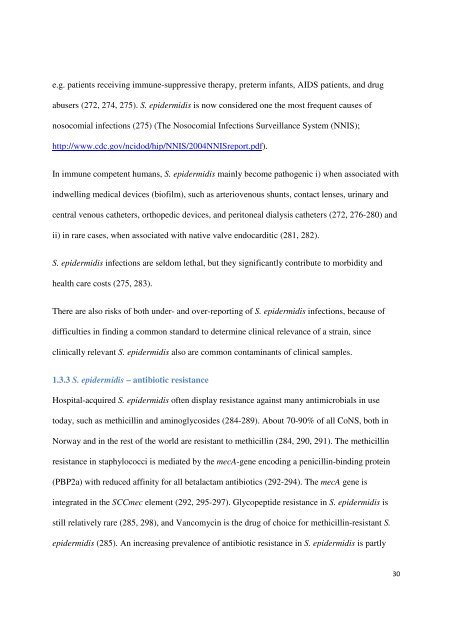Staphylococcus epidermidis - virulence factors and innate ... - Munin
Staphylococcus epidermidis - virulence factors and innate ... - Munin
Staphylococcus epidermidis - virulence factors and innate ... - Munin
Create successful ePaper yourself
Turn your PDF publications into a flip-book with our unique Google optimized e-Paper software.
e.g. patients receiving immune-suppressive therapy, preterm infants, AIDS patients, <strong>and</strong> drug<br />
abusers (272, 274, 275). S. <strong>epidermidis</strong> is now considered one the most frequent causes of<br />
nosocomial infections (275) (The Nosocomial Infections Surveillance System (NNIS);<br />
http://www.cdc.gov/ncidod/hip/NNIS/2004NNISreport.pdf).<br />
In immune competent humans, S. <strong>epidermidis</strong> mainly become pathogenic i) when associated with<br />
indwelling medical devices (biofilm), such as arteriovenous shunts, contact lenses, urinary <strong>and</strong><br />
central venous catheters, orthopedic devices, <strong>and</strong> peritoneal dialysis catheters (272, 276-280) <strong>and</strong><br />
ii) in rare cases, when associated with native valve endocarditic (281, 282).<br />
S. <strong>epidermidis</strong> infections are seldom lethal, but they significantly contribute to morbidity <strong>and</strong><br />
health care costs (275, 283).<br />
There are also risks of both under- <strong>and</strong> over-reporting of S. <strong>epidermidis</strong> infections, because of<br />
difficulties in finding a common st<strong>and</strong>ard to determine clinical relevance of a strain, since<br />
clinically relevant S. <strong>epidermidis</strong> also are common contaminants of clinical samples.<br />
1.3.3 S. <strong>epidermidis</strong> – antibiotic resistance<br />
Hospital-acquired S. <strong>epidermidis</strong> often display resistance against many antimicrobials in use<br />
today, such as methicillin <strong>and</strong> aminoglycosides (284-289). About 70-90% of all CoNS, both in<br />
Norway <strong>and</strong> in the rest of the world are resistant to methicillin (284, 290, 291). The methicillin<br />
resistance in staphylococci is mediated by the mecA-gene encoding a penicillin-binding protein<br />
(PBP2a) with reduced affinity for all betalactam antibiotics (292-294). The mecA gene is<br />
integrated in the SCCmec element (292, 295-297). Glycopeptide resistance in S. <strong>epidermidis</strong> is<br />
still relatively rare (285, 298), <strong>and</strong> Vancomycin is the drug of choice for methicillin-resistant S.<br />
<strong>epidermidis</strong> (285). An increasing prevalence of antibiotic resistance in S. <strong>epidermidis</strong> is partly<br />
30
















